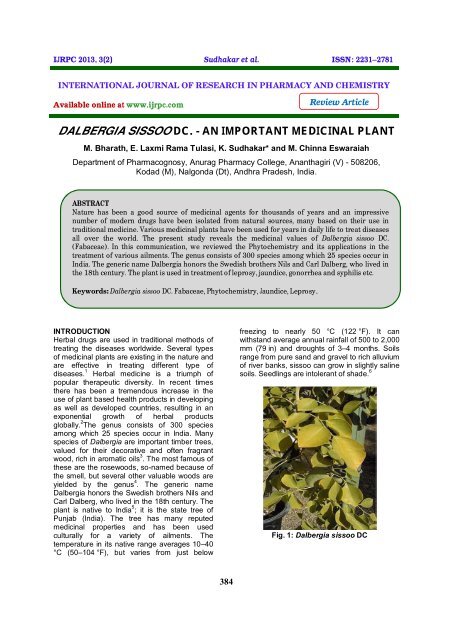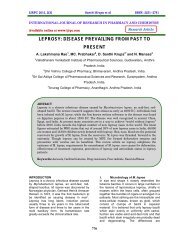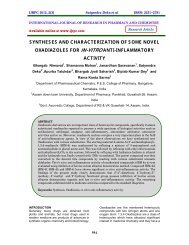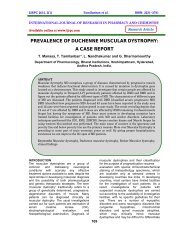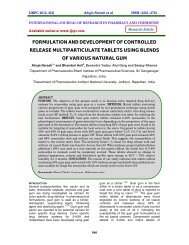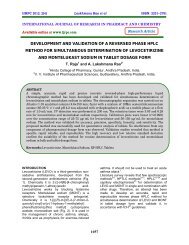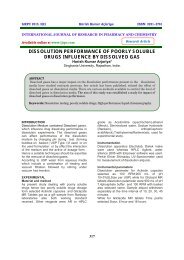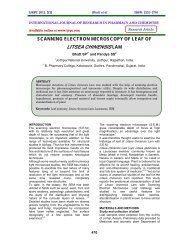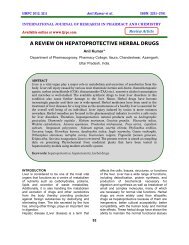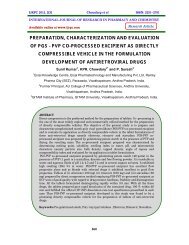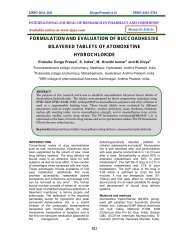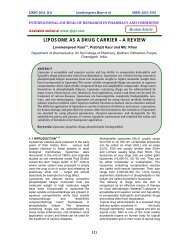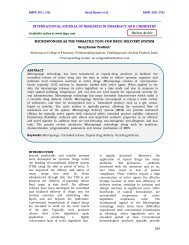dalbergia sissoo dc. - an important medicinal plant - ijrpc
dalbergia sissoo dc. - an important medicinal plant - ijrpc
dalbergia sissoo dc. - an important medicinal plant - ijrpc
You also want an ePaper? Increase the reach of your titles
YUMPU automatically turns print PDFs into web optimized ePapers that Google loves.
IJRPC 2013, 3(2) Sudhakar et al. ISSN: 22312781<br />
INTERNATIONAL JOURNAL OF RESEARCH IN PHARMACY AND CHEMISTRY<br />
Available online at www.<strong>ijrpc</strong>.com<br />
Review Article<br />
DALBERGIA SISSOO DC. - AN IMPORTANT MEDICINAL PLANT<br />
M. Bharath, E. Laxmi Rama Tulasi, K. Sudhakar* <strong>an</strong>d M. Chinna Eswaraiah<br />
Department of Pharmacognosy, Anurag Pharmacy College, An<strong>an</strong>thagiri (V) - 508206,<br />
Kodad (M), Nalgonda (Dt), Andhra Pradesh, India.<br />
ABSTRACT<br />
Nature has been a good source of <strong>medicinal</strong> agents for thous<strong>an</strong>ds of years <strong>an</strong>d <strong>an</strong> impressive<br />
number of modern drugs have been isolated from natural sources, m<strong>an</strong>y based on their use in<br />
traditional medicine. Various <strong>medicinal</strong> pl<strong>an</strong>ts have been used for years in daily life to treat diseases<br />
all over the world. The present study reveals the <strong>medicinal</strong> values of Dalbergia <strong>sissoo</strong> DC.<br />
(Fabaceae). In this communication, we reviewed the Phytochemistry <strong>an</strong>d its applications in the<br />
treatment of various ailments. The genus consists of 300 species among which 25 species occur in<br />
India. The generic name Dalbergia honors the Swedish brothers Nils <strong>an</strong>d Carl Dalberg, who lived in<br />
the 18th century. The pl<strong>an</strong>t is used in treatment of leprosy, jaundice, gonorrhea <strong>an</strong>d syphilis etc.<br />
Keywords: Dalbergia <strong>sissoo</strong> DC. Fabaceae, Phytochemistry, Jaundice, Leprosy.<br />
INTRODUCTION<br />
Herbal drugs are used in traditional methods of<br />
treating the diseases worldwide. Several types<br />
of <strong>medicinal</strong> pl<strong>an</strong>ts are existing in the nature <strong>an</strong>d<br />
are effective in treating different type of<br />
diseases. 1 Herbal medicine is a triumph of<br />
popular therapeutic diversity. In recent times<br />
there has been a tremendous increase in the<br />
use of pl<strong>an</strong>t based health products in developing<br />
as well as developed countries, resulting in <strong>an</strong><br />
exponential growth of herbal products<br />
globally. 2 The genus consists of 300 species<br />
among which 25 species occur in India. M<strong>an</strong>y<br />
species of Dalbergia are import<strong>an</strong>t timber trees,<br />
valued for their decorative <strong>an</strong>d often fragr<strong>an</strong>t<br />
wood, rich in aromatic oils 3 . The most famous of<br />
these are the rosewoods, so-named because of<br />
the smell, but several other valuable woods are<br />
yielded by the genus 4 . The generic name<br />
Dalbergia honors the Swedish brothers Nils <strong>an</strong>d<br />
Carl Dalberg, who lived in the 18th century. The<br />
pl<strong>an</strong>t is native to India 5 ; it is the state tree of<br />
Punjab (India). The tree has m<strong>an</strong>y reputed<br />
<strong>medicinal</strong> properties <strong>an</strong>d has been used<br />
culturally for a variety of ailments. The<br />
temperature in its native r<strong>an</strong>ge averages 10–40<br />
°C (50–104 °F), but varies from just below<br />
freezing to nearly 50 °C (122 °F). It c<strong>an</strong><br />
withst<strong>an</strong>d average <strong>an</strong>nual rainfall of 500 to 2,000<br />
mm (79 in) <strong>an</strong>d droughts of 3–4 months. Soils<br />
r<strong>an</strong>ge from pure s<strong>an</strong>d <strong>an</strong>d gravel to rich alluvium<br />
of river b<strong>an</strong>ks, <strong>sissoo</strong> c<strong>an</strong> grow in slightly saline<br />
soils. Seedlings are intoler<strong>an</strong>t of shade. 6<br />
Fig. 1: Dalbergia <strong>sissoo</strong> DC<br />
384
IJRPC 2013, 3(2) Sudhakar et al. ISSN: 22312781<br />
TAXONOMICAL CLASSIFICATION 7-9<br />
Domain: Eukaryota<br />
Kingdom: Pl<strong>an</strong>tae<br />
Division: Magnoliophyta<br />
Phylum: Tracheophyta<br />
Class: Magnoliopsida<br />
Order: Fabales<br />
Family: Fabaceae<br />
Tribe: Dalbergieae<br />
Genus: Dalbergia<br />
Species: D. <strong>sissoo</strong><br />
Binomial name: Dalbergia <strong>sissoo</strong> DC.<br />
SYNONYMS 4<br />
Amerimnon <strong>sissoo</strong> (Roxb.) Kuntze<br />
Amerimnon P.Browne<br />
Coroya Pierre<br />
Ecastaphyllum P.Browne<br />
Miscolobium Vogel<br />
Triptolemea Mart.<br />
Fig. 3: Compound leaves <strong>an</strong>d immature fruits<br />
Flowers are whitish to pink, fragr<strong>an</strong>t, nearly<br />
sessile, up to 1.5 cm (0.59 in) long <strong>an</strong>d in dense<br />
clusters 5–10 cm (2.0–3.9 in) in length. Pods are<br />
oblong, flat, thin, strap-like 4–8 cm (1.6–3.1 in)<br />
long, 1 cm (0.39 in) wide <strong>an</strong>d light brown. They<br />
contain 1–5 flat be<strong>an</strong>-shaped seeds 8–10 mm<br />
(0.31–0.39 in) long.<br />
COMMON NAMES 10-12<br />
S<strong>an</strong>skrit: Shinshapa, aguru<br />
English: Indi<strong>an</strong> Rosewood, Bombay blackwood<br />
Hindi: Shisham ,sissu ,sissai , sisam<br />
Tamil: Sisso, gette<br />
K<strong>an</strong>nada: Beeti, shista baage, agaru, bindi<br />
Bengali: Shishu<br />
French: Ébénier ju<strong>an</strong>e<br />
Arabic: Arabic<br />
BOTANICAL DESCRIPTION<br />
Dalbergia <strong>sissoo</strong> DC is a medium to large tree of<br />
about 25 meters high with grey-yellow trunk,<br />
longitudinal crack, <strong>an</strong>d downcast twig. Leaves<br />
are leathery, pinnately compound, with about<br />
five alternate leaflets. Leaf stalk (petiole)<br />
measures about 15 cm long, each leaflet widest<br />
at the base, to 6 cm long with a fine pointed tip.<br />
Figure 4: Flowers<br />
They have a long taproot <strong>an</strong>d numerous surface<br />
roots which produce suckers. Young shoots are<br />
downy <strong>an</strong>d drooping, established stems with<br />
light brown to dark grey bark up to 2.5 cm<br />
(0.98 in) thick, shed in narrow strips, large upper<br />
br<strong>an</strong>ches support a spreading crown. The pl<strong>an</strong>t<br />
has ability to fix nitrogen from the atmosphere<br />
through bacteria located in nodules present in<br />
the root system. The leaf litter that accumulates<br />
<strong>an</strong>d decomposes also contributes to soil fertility<br />
by adding additional nitrogen, potassium, iron,<br />
m<strong>an</strong>g<strong>an</strong>ese, <strong>an</strong>d org<strong>an</strong>ic carbon. Propagation is<br />
done by seeds <strong>an</strong>d also by root suckers. Various<br />
parts of the pl<strong>an</strong>t are used as medicines.<br />
FLOWERING PERIOD 7 : March - May<br />
Fig. 2: Trunk<br />
GEOGRAPHICAL DISTRIBUTION<br />
11, 13, 14<br />
Dalbergia <strong>sissoo</strong> is found in tropical to<br />
subtropical climates in natural <strong>an</strong>d pl<strong>an</strong>ted<br />
forests, very widely distributed in Pakist<strong>an</strong>, India,<br />
Afgh<strong>an</strong>ist<strong>an</strong>, Persia, Iraq, Kenya <strong>an</strong>d T<strong>an</strong>z<strong>an</strong>ia.<br />
385
IJRPC 2013, 3(2) Sudhakar et al. ISSN: 22312781<br />
TRADITIONAL USES 15<br />
Various parts of Dalbergia <strong>sissoo</strong> are<br />
traditionally used in treating different diseases<br />
<strong>an</strong>d are mentioned below.<br />
Seeds: Sissoo oil is used to treat blue itching,<br />
burning on the skin, <strong>an</strong>d scabies.<br />
Leaves: Finely ground paste of 8-10 leaves of<br />
<strong>sissoo</strong> <strong>an</strong>d 25gm of palm c<strong>an</strong>dy taken in the<br />
morning alleviates profuse menstruation. 50-100<br />
ml decoction of the leaves taken thrice in a day<br />
is useful in Painful micturition <strong>an</strong>d to cure boils<br />
<strong>an</strong>d pimples. 10-15 ml juice (leaves) taken thrice<br />
in a day helps in eliminating pus in urine <strong>an</strong>d in<br />
treating jaundice. The leaves warmed <strong>an</strong>d tied<br />
on breast, <strong>an</strong>d consuming the decoction of the<br />
leaves removes swelling of the breast.<br />
Bark: 3-6gm powdered bark or decoction of the<br />
leaves is helpful in gonorrhea. Decoction of the<br />
bark <strong>an</strong>d leaf is given in leprosy. Make a<br />
decoction of 10gm <strong>sissoo</strong> bark with 500gm of<br />
water <strong>an</strong>d it should be boiled till the liquid<br />
reduces to half. Mix the juice of the bark <strong>an</strong>d<br />
consume for forty days every morning which<br />
helps in leprosy.<br />
Sissoo nectar: Take 20gm of Sissoo nectar,<br />
320gm water, <strong>an</strong>d 160 gm milk. Boil it till only<br />
milk remains. Consume 3 times a day. This milk<br />
cures <strong>an</strong>y type of fever.<br />
CHEMICAL CONSTITUENTS 16<br />
Leaves: Isoflavone-O-glycoside.<br />
Flowers: Biochenin A, tectorigenin, 7, 4<br />
dimethyle tectorigenin <strong>an</strong>d 7-O- methyle<br />
tectorigenin.<br />
Green pods: Mesoinisitol, 7-O- methyle<br />
tectorigenin <strong>an</strong>d 4’-rhamnoglucoside.<br />
Mature pods: Isocaviumin, tectorigenin,<br />
dalbergin, caviunin <strong>an</strong>d t<strong>an</strong>nins.<br />
Stem bark: Dalberginone, dalbergin, methyl<br />
dalbergin <strong>an</strong>d dalbergichromene.<br />
Heartwood: Dalbergin, nordalberginones,<br />
dalbergichromene, fixid oil <strong>an</strong>d essential oils.<br />
17, 18, 19<br />
USES<br />
Ayurveda: Leaf juice for eye ailments,<br />
considering the wood <strong>an</strong>d bark as abortifacient,<br />
<strong>an</strong>thelmintic, <strong>an</strong>tipyretic, aphrodisiac,<br />
expector<strong>an</strong>t, <strong>an</strong>d refriger<strong>an</strong>t. The wood <strong>an</strong>d bark<br />
for <strong>an</strong>al disorders, blood diseases, burning<br />
sensations, dysentery, dyspepsia, leucoderma,<br />
<strong>an</strong>d skin ailments.<br />
Yun<strong>an</strong>i: The wood for blood disorders, burning<br />
sensations, eye <strong>an</strong>d nose disorders, scabies,<br />
scalding urine, stomach problems, <strong>an</strong>d syphilis.<br />
The alterative wood is used in India for boils,<br />
eruptions, leprosy <strong>an</strong>d nausea.<br />
Different parts such as roots, bark, wood, leaves<br />
<strong>an</strong>d seeds are being used as remedy in m<strong>an</strong>y<br />
diseases including skin diseases, blood<br />
diseases, syphilis, stomach problems,<br />
dysentery, nausea, eye <strong>an</strong>d nose disorders,<br />
aphrodisiac, expector<strong>an</strong>t. Leaf extract has been<br />
used to treat sore throats, heart problems,<br />
dysentery, syphilis, <strong>an</strong>d gonorrhea. In India <strong>an</strong>d<br />
Nepal rural people use Dalbergia <strong>sissoo</strong> leaves<br />
to treat <strong>an</strong>imals suffering from non-specific<br />
diarrhoea.<br />
Herbal preparation of Dalbergia <strong>sissoo</strong> <strong>an</strong>d<br />
Datura stramoium with cow urine c<strong>an</strong> be used<br />
as a potent <strong>an</strong>tiseptic preparation for prevention<br />
<strong>an</strong>d treatment of chronic bacterial infections.<br />
People use twigs of <strong>sissoo</strong> to cle<strong>an</strong> their teeth,<br />
root is astringent.<br />
RECENT DEVELOPMENTS IN THE<br />
RESEARCH AREA OF DALBERGIA SISSOO<br />
Mohammad Asif et al conducted a study in<br />
2009, Anti-inflammatory activity of eth<strong>an</strong>olic<br />
extract of Dalbergia <strong>sissoo</strong> (Roxb.) bark. It c<strong>an</strong><br />
be concluded that the eth<strong>an</strong>olic extract of<br />
Dalbergia <strong>sissoo</strong> bark at 1000 mg/kg showed<br />
the most potent <strong>an</strong>ti-inflammatory activity<br />
compared to the other groups (300 <strong>an</strong>d 500<br />
mg/kg) throughout the observation period. 20<br />
Mohammad Asif et al conducted a study in<br />
2011, phytochemical investigation <strong>an</strong>d<br />
evaluation of <strong>an</strong>ti-nociceptive activity of<br />
eth<strong>an</strong>olic extract of Dalbergia <strong>sissoo</strong> (Roxb.)<br />
bark. They concluded that (300, 500 <strong>an</strong>d 1000<br />
mg/kg) doses of extract exhibited signific<strong>an</strong>t <strong>an</strong>d<br />
dose dependent <strong>an</strong>ti-nociceptive activity which<br />
may be due to presence of flav<strong>an</strong>oids. 21<br />
Harsha Kharkwal et al conducted a study in<br />
2012, Anti-termite activity of heartwood of<br />
Dalbergia <strong>sissoo</strong> Roxb. Ex.Dc. It concluded that<br />
the pl<strong>an</strong>t extracts c<strong>an</strong> be used as <strong>an</strong> alternative<br />
for synthetic pesticides for termite control in<br />
buildings. 22<br />
P<strong>an</strong>kaj singh nir<strong>an</strong>j<strong>an</strong> et al conducted a study<br />
in 2010; Anti-diabetic activity of eth<strong>an</strong>olic extract<br />
of Dalbergia <strong>sissoo</strong> L. leaves in allox<strong>an</strong> induced<br />
diabetic rats. They concluded that the eth<strong>an</strong>olic<br />
extract of the Dalbergia <strong>sissoo</strong> leaves are 12%<br />
more effective in reducing the BGL compared to<br />
st<strong>an</strong>dard Glibenclamide. 23<br />
Jaspreet Kaur Sid<strong>an</strong>a et al conducted a study<br />
in 2012, Analgesic <strong>an</strong>d <strong>an</strong>ti-inflammatory<br />
activities of Dalbergia <strong>sissoo</strong> leaves extract.<br />
They concluded that the extract possesses both<br />
<strong>an</strong>algesic <strong>an</strong>d <strong>an</strong>ti- inflammatory properties. 24<br />
Mallinath H. Hugar et al conducted a study in<br />
2010, phytochemical <strong>an</strong>d pharmacological<br />
386
IJRPC 2013, 3(2) Sudhakar et al. ISSN: 22312781<br />
studies of eth<strong>an</strong>ol extract of Dalbergia <strong>sissoo</strong><br />
seeds. An approach for the in-vivo <strong>an</strong>algesic<br />
<strong>an</strong>d <strong>an</strong>tipyretic activities. It concluded that<br />
Dalbergia <strong>sissoo</strong> seeds extract has moderate<br />
<strong>an</strong>algesic <strong>an</strong>d remarkable <strong>an</strong>tipyretic activities. 25<br />
Nitinkumar Upwar et al conducted a study in<br />
2011, Evaluation of <strong>an</strong>ti-helminthic activity of<br />
Dalbergia <strong>sissoo</strong> Roxb. The study indicated the<br />
potential usefulness of Dalbergia <strong>sissoo</strong> Roxb.<br />
against helminthic infections. 26<br />
Neeraj S. Vyawahare et al Conducted a study<br />
in 2012, Anti-diabetic Evaluation of Dalbergia<br />
<strong>sissoo</strong> against allox<strong>an</strong> induced diabetes mellitus<br />
in wistar albino rats. They concluded that<br />
eth<strong>an</strong>olic extract of Dalbergia <strong>sissoo</strong> bark<br />
possesses signific<strong>an</strong>t <strong>an</strong>ti-diabetic activity. 27<br />
Arvinder Kaur et al conducted a study in 2011,<br />
Evaluation of <strong>an</strong>tioxid<strong>an</strong>t potential of stem bark<br />
extract of Dalbergia <strong>sissoo</strong>. Finally results<br />
shown, among the different extracts of stem<br />
bark of the pl<strong>an</strong>t Dalbergia <strong>sissoo</strong>, chloroform<br />
extract possesses marked <strong>an</strong>tioxid<strong>an</strong>t activity,<br />
whereas meth<strong>an</strong>olic extract shown moderate<br />
activity in different in vitro <strong>an</strong>ti-oxid<strong>an</strong>t assays. 28<br />
Shazia Sult<strong>an</strong>a et al conducted a survey on,<br />
Indigenous knowledge of folk herbal medicines<br />
by the women of district Chakwal, Pakist<strong>an</strong>. This<br />
survey describes that, crush the leaves <strong>an</strong>d<br />
boiled in water <strong>an</strong>d the filtrate obtained is used<br />
to wash hair for removing d<strong>an</strong>druff <strong>an</strong>d for long<br />
hair. 29<br />
S Ch<strong>an</strong>dra et al conducted a study on Antiinflammatory<br />
activity of Dalbergia <strong>sissoo</strong> leaves.<br />
They concluded that the D. <strong>sissoo</strong> leaf extract<br />
possessed signific<strong>an</strong>t <strong>an</strong>ti-inflammatory activity<br />
(in acute, sub-acute <strong>an</strong>d chronic models of<br />
inflammation) without <strong>an</strong>y side effects on gastric<br />
mucosa. 30<br />
7, 31<br />
LIST OF SPECIES OF IN DALBERGIA GENUS<br />
1 (Rosewood) D. abrahamii 26 (Bombay Blackwood) D. latifolia<br />
2 (Burmese Rosewood) D. bariensis 27 (Bois de Rose) D. maritima<br />
3 (Palis<strong>an</strong>der) D. baronii 28 (Afric<strong>an</strong> Blackwood) D. mel<strong>an</strong>oxylon<br />
4 (Caroba-Brava) D. brasiliensis 29 (C<strong>an</strong>ela-De-Burro) D. miscolobium<br />
5 (Brown's Indi<strong>an</strong> Rosewood) D. brownei 30 (Rosewood) D. mollis<br />
6 (Gr<strong>an</strong>adillo) D. calycina 31 (Bejuco De Peseta) D. monetaria<br />
7 (Dalbergia) D. c<strong>an</strong>denatensis 32 (Bahia Rosewood) D. nigra<br />
8 (Jacar<strong>an</strong>d) D. catingicola 33 (Fragr<strong>an</strong>t Rosewood) D. odorifera<br />
9 (Brazili<strong>an</strong> Kingwood) D. cearensis 34 (Burma Rosewood) D. oliveri<br />
10 (Rose Wood) D. cochinchinensis 35 (Dalbergia) D. palauensis<br />
11 (Gr<strong>an</strong>adillo) D. cubilquitzensis 36 (Dalbergia) D. palauensis<br />
12 (Burma Blackwood) D. cultrata 37 (Akar Laka) D. parviflora<br />
13 (Burma Blackwood) D. cultrata var. cultrata 38 (Nambar) D. retusa var. retusa<br />
14 (Bastiao-De-Arruda) D. decipularis 39 (Rabo-De-Guariba) D. riparia<br />
15 (Bejuco De Peseta) D. ecastaphyllum 40 (Malabar Blackwood) D. sissoides<br />
16 (Mussuta) D. eleg<strong>an</strong>s 41 (Indi<strong>an</strong> Rosewood) D. <strong>sissoo</strong><br />
17 (Jacar<strong>an</strong>d -Rosa) D. foliolosa 42 (Sabuar<strong>an</strong>a) D. spruce<strong>an</strong>a<br />
18 (Jacar<strong>an</strong>dá-Rosa) D. frutescens 43 (Rosewood) D. stevensonii<br />
19 (Pau-De-Estribo) D. frutescens var. frutescens 44 (Ver“nica) D. subcymosa<br />
20 (Jacar<strong>an</strong>d -Rosa) D. frutescens var. tomentosa 45 (Rosewood) D. trichocarpa<br />
21 (Eb<strong>an</strong>o) D. funera 46 (Dalbergia) D. tucurensis<br />
22 (Tripa-De-Galinha) D. gracilis 47 (Heliotropio) D. villosa<br />
23 (Sebastiao-De-Arruda) D. hortensis 48 (Heliotropio) D. villosa var. barreto<strong>an</strong>a<br />
24 (Jacar<strong>an</strong>da) D. inundata 49 (Rosewood) D. xerophila<br />
25 (Shisham) D. l<strong>an</strong>ceolaria 50 (Yucat<strong>an</strong> Rosewood) D.yucatensis<br />
ACKNOWLEDGEMENTS<br />
We are th<strong>an</strong>kful to the m<strong>an</strong>agement of Anurag<br />
pharmacy college, Kodad, Nalgonda, A.P, India,<br />
for providing all facilities during this work.<br />
REFERENCES<br />
1. Avinash Saurabh, An<strong>an</strong>t Shekher<br />
Mishra, Sourabh Gupta. A review on<br />
<strong>medicinal</strong> pl<strong>an</strong>t which may effective in<br />
the treatment of ulcer or which show <strong>an</strong>ti<br />
ulcer activities; International journal of<br />
biopharmaceutical & toxicological<br />
research. (2012); 2(1): 266-276.<br />
2. Saurabh Srivastav, Pradeep Singh et<br />
al., Achyr<strong>an</strong>thes aspera - An import<strong>an</strong>t<br />
<strong>medicinal</strong> pl<strong>an</strong>t: A review; J. Nat. Prod.<br />
Pl<strong>an</strong>t Resources. (2011); 1 (1): 1-14.<br />
3. Neeru Vasudeva, M<strong>an</strong>isha Vats, SK<br />
Sharma, Satish Sard<strong>an</strong>a. Chemistry <strong>an</strong>d<br />
biological activities of the genus<br />
Dalbergia - A review, Pharmacognosy<br />
Reviews. 2009; 3(6): 307-319.<br />
4. http://en.wikipedia.org/wiki/Dalbergia<br />
5. http://www.taipeiexpopark.tw/ct.asp?xItem=88548&ctNod<br />
e=7508&mp=4<br />
387
IJRPC 2013, 3(2) Sudhakar et al. ISSN: 22312781<br />
6. M.I. Sheikh, A quick guide to useful<br />
nitrogen fixing trees from around the<br />
world, NFT Highlights, NFTA 89-07,<br />
December 1989<br />
7. http://zipcodezoo.com/Pl<strong>an</strong>ts/D/Dalbergi<br />
a_<strong>sissoo</strong>/<br />
8. http://www.ecoindia.com/flora/trees/india<br />
n-rosewood-tree.html<br />
9. http://en.wikipedia.org/wiki/Dalbergia_si<br />
ssoo<br />
10. Madhava chetty K, Sivaji K. <strong>an</strong>d Tulasi<br />
Rao K. Flowering pl<strong>an</strong>ts of Chittoor<br />
District Andhra Pradesh, India, Second<br />
edition, Students offset printers, Tirupati,<br />
2008, Page no: 88.<br />
11. http://parisaramahiti.kar.nic.in/Medicinal<br />
_pl<strong>an</strong>ts_new/med%20pl<strong>an</strong>ts/p81.html<br />
12. http://parisaramahiti.kar.nic.in/Medicinal<br />
_pl<strong>an</strong>ts_new/med%20pl<strong>an</strong>ts/p81.html<br />
13. http://www.iccs.edu/folkmed/P28.php<br />
14. http://keys.luci<strong>dc</strong>entral.org/keys/v3/eafri<br />
net/weeds/key/weeds/Media/Html/Dalbe<br />
rgia_<strong>sissoo</strong>_(Indi<strong>an</strong>_Rosewood)<br />
15. Hari Sh<strong>an</strong>kar Lal <strong>an</strong>d S<strong>an</strong>jay Singh.<br />
Ethno<strong>medicinal</strong> uses of Dalbergia<br />
<strong>sissoo</strong> Roxb in Jharkh<strong>an</strong>d, International<br />
journal of ayurvedic <strong>an</strong>d herbal<br />
medicine. (2012); 2(1):198:201<br />
16. http://www.mpbd.info/pl<strong>an</strong>ts/<strong>dalbergia</strong><strong>sissoo</strong>.php<br />
17. http://www.hort.purdue.edu/newcrop/duk<br />
e_energy/Dalbergia_<strong>sissoo</strong>.html<br />
18. Mukhtar Huss<strong>an</strong>i Shah, Irum Mukhtar<br />
<strong>an</strong>d Salik Nawaz Kh<strong>an</strong>. Medicinal<br />
import<strong>an</strong>ce <strong>an</strong>d association of<br />
pathological constraints with Dalbergia<br />
<strong>sissoo</strong>. Pak. J. Phytopathol, 2010;<br />
22 (2):135-138.<br />
19. http://www.flowersofindia.net/catalog/sli<br />
des/Shisham.html<br />
20. Mohammad Asif <strong>an</strong>d Arun Kumar, Antiinflammatory<br />
activity of eth<strong>an</strong>olic extract<br />
of Dalbergia <strong>sissoo</strong> (Roxb.) bark.<br />
Malaysi<strong>an</strong> Journal of Pharmaceutical<br />
Sciences. (2009); 7(1): 39-50.<br />
21. Mohammad Asif <strong>an</strong>d Arun Kumar,<br />
Photochemical investigation <strong>an</strong>d<br />
evaluation of <strong>an</strong>tinociceptive activity of<br />
eth<strong>an</strong>olic extract of Dalbergia <strong>sissoo</strong><br />
(Roxb.) bark. Journal of natural science,<br />
Biology <strong>an</strong>d Medicine. (2011); 2(1): 76-<br />
79.<br />
22. Kharkwal H, Joshi D. D, Kharkwal A,<br />
P<strong>an</strong>thari P et al. Anti-termite activity of<br />
heartwood of Dalbergia <strong>sissoo</strong> Roxb.<br />
Ex.Dc. Asi<strong>an</strong> pacific journal of<br />
biomedicine. (2012): 1-4.<br />
23. Nir<strong>an</strong>j<strong>an</strong> P.S, Singh D, Prajapati K <strong>an</strong>d<br />
Jain S.K. Antidiabetic activity of<br />
eth<strong>an</strong>olic extract of Dalbergia <strong>sissoo</strong> L.<br />
leaves in allox<strong>an</strong>induced diabetic rats.<br />
International Journal of Current<br />
Pharmaceutical Research. (2010); 2(2):<br />
24-27.<br />
24. Sid<strong>an</strong>a J.K, Saini V <strong>an</strong>d Dahiya S.<br />
Analgesic <strong>an</strong>d <strong>an</strong>ti-inflammatory<br />
activities of Dalbergia <strong>sissoo</strong> leaves<br />
extract. International journal of natural<br />
product science. (2012); Spl Issue 1:<br />
134.<br />
25. Hugar M.H, Hosam<strong>an</strong>i K.M <strong>an</strong>d Ahmed<br />
L. Phytochemical <strong>an</strong>d pharmacological<br />
studies of eth<strong>an</strong>ol extract of Dalbergia<br />
<strong>sissoo</strong> seeds. An approach for the invivo<br />
<strong>an</strong>algesic <strong>an</strong>d <strong>an</strong>tipyretic activities.<br />
International Journal of Pharma <strong>an</strong>d Bio<br />
Sciences. (2010); 1(4): 272-280.<br />
26. Nitinkumar Upwar, Patel R, Waseem N<br />
et al. Evaluation of <strong>an</strong>thelmintic activity<br />
of Dalbergia <strong>sissoo</strong> Roxb. International<br />
Journal of Pharmaceutical Sciences <strong>an</strong>d<br />
Research. (2011); 2(1): 171-174.<br />
27. Pund K.V, Vyawahare N. S, Gadakh R.<br />
T et al. Antidiabetic Evaluation of<br />
Dalbergia <strong>sissoo</strong> against allox<strong>an</strong><br />
induced diabetes mellitus in wistar<br />
albino rats. J. Nat. Prod. Pl<strong>an</strong>t Resour.<br />
(2012); 2 (1): 81-88.<br />
28. Kaur A, Singh S, Ch<strong>an</strong>dra P et al.<br />
Evaluation of <strong>an</strong>tioxid<strong>an</strong>t potential of<br />
stem bark extract of Dalbergia <strong>sissoo</strong>,<br />
Journal of Pharmacy Research, (2011);<br />
4(10): 3439-3441.<br />
29. Shazia Sult<strong>an</strong>a,<br />
Mir Ajab Kh<strong>an</strong>, Mushtaq Ahmad <strong>an</strong>d<br />
Muhammad Zafar, Indigenous<br />
Knowledge of Folk Herbal Medicines by<br />
the Women of District Chakwal,<br />
Pakist<strong>an</strong>. Ethnobot<strong>an</strong>ical Leaflets.<br />
(2006); 10: 243-253.<br />
30. Hajare S.W, Ch<strong>an</strong>dra S et al. Antiinflammatory<br />
activity of Dalbergia<br />
<strong>sissoo</strong> leaves, Fitoterapia. (2001);<br />
72(2): 131-139.<br />
31. http://www.wood-database.com/lumberidentification/hardwoods/<strong>sissoo</strong>/<br />
388


